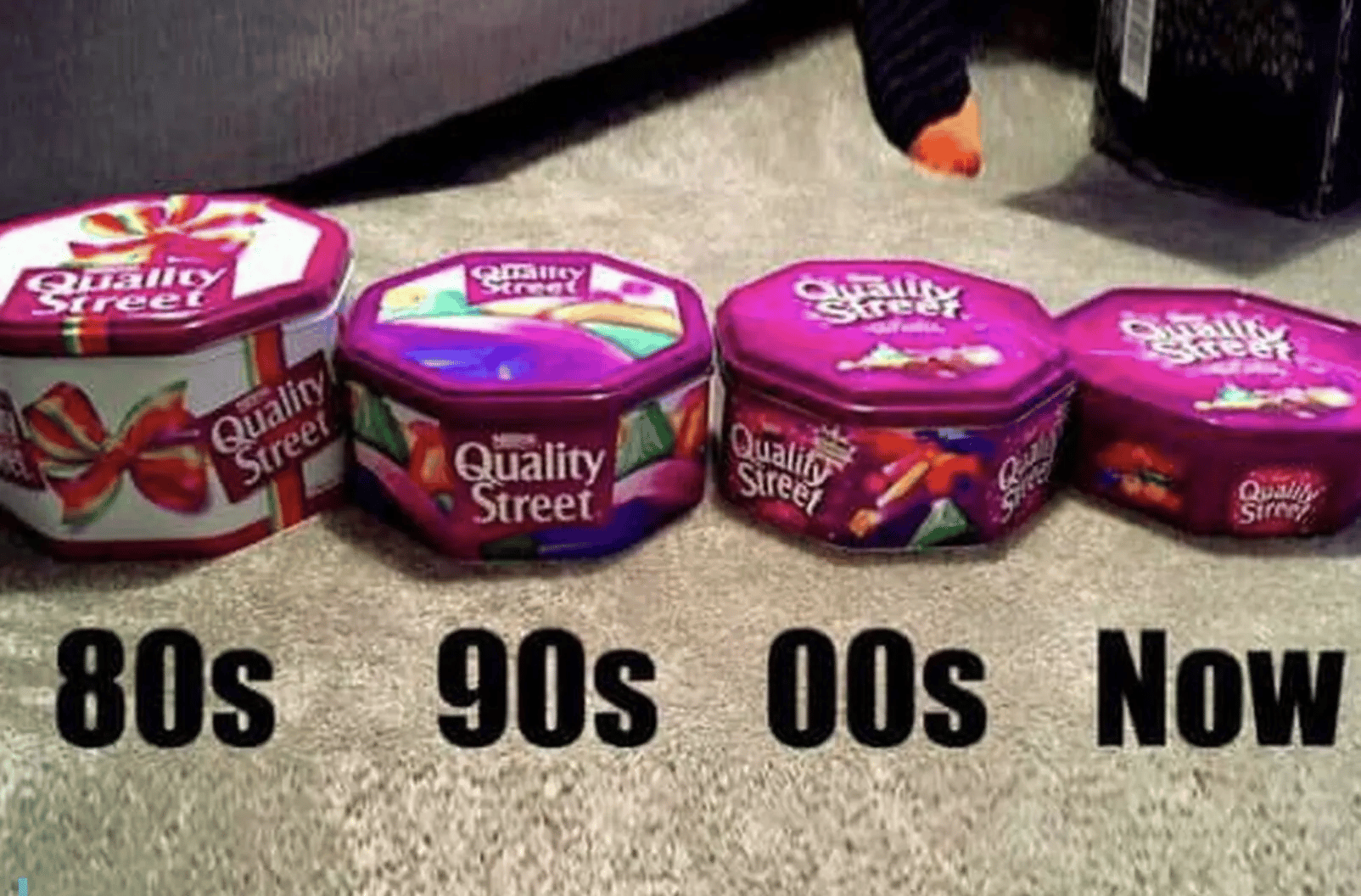- Trail of Change
- Posts
- The new geography of value brands
The new geography of value brands
How geopolitical shifts, extraordinary cost-benefit, and the power of enthusiasts are creating a new wave of irresistible brands

The post-pandemic inflationary shock and wage stagnation in many parts of the world are powerful vectors of change, affecting the political chessboard, possibly our collective sense of isolation and, of course, our purchase choices.
Squeezed purchasing power is pushing many people to seek alternatives. The classic paths for established giants, in fast-moving consumer goods in particular, are to go through shrinkflation and reformulating products with cheaper ingredients. In supermarkets and pharmacies, this is when private labels usually take off.

via Will Poskett
But there is another, more interesting path opening up. In several categories, brands are emerging that deliver exceptional performance at more accessible prices. This movement is riding a wave of growing geopolitical and cultural decentralization (which is a topic for another text in itself!) and is accelerated by the issue of tariffs. With the origin of products coming under more scrutiny, the characteristics we associate with countries are changing rapidly.
On this new map, the old bastions of quality like 'German engineering,' 'designed in California,' or 'Swiss movement' (if we’re talking about watches) still matter, but their monopoly on our perception is crumbling. They are no longer the only possible seals of approval, and not everyone wants to - or can - pay the premium for them. This opens the door for brands to tell their stories in different ways.
Consumer electronics: the proliferation of Chinese value and premium brands and “Chifi”
In consumer electronics, China is rapidly moving beyond its past of low-quality (or even high-quality) copies of Western products and is moving towards using its productive efficiencies to create brands that challenge more traditional competitors not only in price, but increasingly in technical features and quality.
A less obvious manifestation than what is happening in the automotive market (and without the direct incentive of the Chinese government) that illustrates this phenomenon very well is the idea of Chifi, a concept that mixes China with High Fidelity - and which is a great analogy for this new role of Chinese brands in the world. Confronting traditional premium audio equipment brands from America, Europe, and Japan like Bose, Sennheiser, or Sony, several Chinese brands are specializing in products with extremely high performance and yet are significantly cheaper than these competitors.
Brands like KZ have changed what is expected from entry-level earphones, with accessible products far superior to the buds that came with your phone, and others are also venturing into the high end of the market, like Moondrop and Hifiman. A second group, among which is FiiO, which has as its mission to elevate the "made in China" reputation, are not just in earphones but also in amplifiers, speakers, and various others. Not content with the unbeatable cost-benefit, some of these brands are highly experimental, both in engineering and design. The differentiator is no longer just access to cheaper components and the ecosystem of suppliers and skilled labor.
watch out, AirPods!
This same logic, not necessarily for value but for performance, applies to various other categories, for example keyboards (Keychron giving Logitech and Razer headaches), robot vacuums (Roborock and Dreame advancing on iRobot, Samsung and other more established ones), handheld consoles (Ayaneo and GPD advancing on Steamdeck and ROG Ally) and many others. But this path is not possible only for brands that manufacture their products in Shenzen and other Chinese industrial hubs…
Perfumery outside the European bubble
The devaluation of the real and the loss of purchasing power in the last decade pushed many historical consumers of imported perfumes towards more accessible alternatives. Brazilian perfumery itself benefited greatly and developed a lot, which was certainly a factor in the internationalization of some of our brands.
This context of eroding purchasing power helps explain in part the growth of Middle Eastern perfumery around the world and notably also in Brazil - another example of the prominence of value brands (in the Kotlerian definition, so focus on perceived value delivery) from outside the West globalizing and gaining ground.
There, fragrances have ancient roots and deep cultural value which in itself is excellent raw material for brand narratives, as is the presence of certain notes and ingredients that are not so common for us like Oud or myrrh. Besides that, they have the reputation of being exceptional in the "technical" metrics like longevity (how long the perfume lasts) and projection (the distance the perfume can be felt) - and where entry-level brands generally fail and luxury brands justify part of the expense.
It's the combination of this technical performance and competitive pricing, packaged in a legitimate cultural narrative, that create a very seductive value proposition, like Chifi's, for brands like Lattafa, Armaf, and Rasasi, all from the United Arab Emirates.
India and specialized high-performance skincare
India is the world's largest producer of generic drugs. This expertise in fine chemistry and pharmaceutical formulations is overflowing into the skincare market and creating global brands, which started by eating at the edges in markets where the Indian diaspora is larger (United Kingdom, USA, Saudi Arabia, United Arab Emirates, etc.).
Two brands in particular have stories that fit here:
Minimalist, founded in 2020, is in a way an Indian response to the Canadian brand The Ordinary, with a total focus on active ingredients and transparent communication, delivering more performance for better prices. In addition to India's local production efficiencies, the greater focus on local skin and climate characteristics also helped - so much so that they were bought by Hindustan Unilever in January of this year.
Dr. Sheth's was founded by two Indian dermatologists and a pharmacist and attacked a weak point of European brands: the lack of R&D for darker skin tones and hot and humid climates - so much so that their tagline is “for Indian skin”. Priced as “mass prestige” in its home country, above entry-level brands but below European ones like Clinique, it was bought in 2022 by the Honasa Consumer group, a “house of brands” owner of Mamaearth, a D2C brand of baby products that is also expanding internationally.
Despite the ANVISA regulatory barrier preventing official sale in Brazil, the latent demand is visible: the brands are already a topic of discussion in enthusiast forums and their products are found in marketplaces through importers - Chifi also started to gain relevance in Brazil that way back around 2020!
What happens to the world of brands if the historical suppliers of raw materials and cheap labor decide to create their own global brands?
Imagine what could happen when other countries with already recognized national commodities or products (Egyptian or Peruvian Pima cotton, Turkish towels, silk and the entire textile industry of Vietnam, etc.) decide to play this game too? Here in Brazil, the weight of Egyptian cotton as a sign of quality has long arrived in home textiles and more recently, along with Pima, it is a claim that helps justify basic t-shirts that cost over 200 or even 300 Brazilian Reais - is there room for value brands based in the countries of origin?
The rules of the game and what all these brands have in common
They are built on less obvious ways of signaling status
Seen from the outside, it may seem that people who choose value brands are simply more rational, more practical, or more dispassionate, but it goes beyond that. One of the things that these brands, the more niche ones in particular, have in common is that they deliver a more exclusive, countercultural or even contrarian sense of belonging, in the sense of knowing things that other people don't. This feeling of being in the know or a connoisseur is a more subtle status signaling than the “I have it, you don’t” of part of the traditional luxury industry. I've already talked about how the search for the is something that moves culture and the place of brands and products in it . In marketing, it seems that many people aim for these less subtle forms and forget the others.
The “pride of spending little”
There are both cultures and individuals who take pride in their ability to bargain. Ultimately, it is also a form of signaling: of intelligence, negotiation skills, of not being gullible or a spendthrift like others.
Know anyone like that?
The marketing world tends to treat rationality as the opposite of emotion, but they almost always go together. Objective performance, validated by trusted third parties at an attractive price, is the perfect rationalization our brain needs to allow itself to embrace the impulse. It's behavior that only seems rational on the surface, but only our discourse or justification about this behavior is.
This is precisely why perceived value, ideally in ways that can be objectively measured, is the most important thing. The feeling of “I'm coming out on top” is a very powerful motivation. I always talk a lot about Game Theory in the relationships between brands that produce and people who buy - an “easy” way to win a negotiation is when you convince your counterpart that they are the ones coming out on top - but some companies have a hard time accepting that this feeling is cemented in the buyer's reality and not in the seller's discourse.
The figure of the insider and the expert plays a key role in building value and in communication
Unlike what it seems on Linkedin, the P for promotion is not the only one that exists in marketing, where it seems the logic of high recurrence and dependence on constant mass communication of fast-moving consumer goods is more rule than exception.
For every Duolingo, Liquid Death or other marketer darling brand that is built primarily on fun branding and a funny presence on social media, there are several others passing unnoticed on your radar and grinding the competition at the intersection of the P's of Price and Product, and this outrageous perceived value is precisely the thing that makes promotion run on its own (or with less effort) at a much lower acquisition cost.
For products that are somehow anchored in performance, no celebrity endorsement will be as persuasive as that of a vibrant community of insiders and enthusiasts, be they foodies, audiophiles, coffee nerds, and so on. Even the role of content creators is different: it is the level of personal involvement and technical knowledge that transmit credibility and authority, not the raw reach - the latter can even be a factor of distrust in some cases. The "toll" to enter this world is to impress real-world customers with a lot of repertoire or interest - a minority of these possibly have an audience of their own. They are the ones who will evaluate the credibility of your claims and help form the opinion of other people looking for guidance.
Now, think about how much this matters even more if LLMs start to play a bigger role in our discovery and evaluation of products, as they will aggregate these online testimonials and make “meta-analyses” of the reviews from specialists and interested parties, like a custom-made and turbocharged Metacritic.
The place of origin in positioning
In our geopolitical rearrangement, using the as an element of differentiation, a narrative pillar and in some cases, even national pride, are paths that make a lot of sense. In the case of several of these brands, the “underdog” position is implicit and everybody loves an underdog.
The value brand positioning can often be a first step towards even more lucrative or consolidated paths

via Giphy
Several brands that are consolidated, broad-appeal or mainstream today were value brands when they were entrants. Think of the Japanese automakers in the 80s in the US and the turnaround of the Korean ones at the end of the 90s around the world. As much as this path may be desirable for some, it is not the only one possible. But where can you go?
Evolving into a cult brand is a natural path for those with an inherently more restricted appeal, especially since being a darling of critics and insiders but not of the general public can increase the value proposition. Think of Mubi in comparison to Netflix or Apple before the iPhone and the migration from PowerPC to Intel chips.
The direction of premium or luxury is also an attractive alternative. This same validation coming from critics, experts and connoisseurs, if taken to a level of more universal recognition and reputation, can allow for higher or even Veblen-esque pricing. Returning to the automakers, it's the story of Lexus.
While a lot of people are signaling status and networking looking for the future of business at the same few events like a Websummit or a SXSW, the future of your category may arise in niche retail, in enthusiast discussions or from a country completely off your radar. And this change doesn't always come from the top of the market, from the aspirational, from branding or the intangible, but from a practical motivation to look for better alternatives for less and from the psychological and social rewards of the results of that motivation.
A follow-up to the previous edition
A reader of the last edition on betification missed an exploration of the mechanisms that lead to gambling addiction and asked for an extra block of text talking about it. I'm happy when this kind of thing happens because the idea of this newsletter is to provoke reflections, and writing long texts is kind of like shouting into the void - you never know what kind of reaction you're causing in people beyond the coldness of analytics. I encourage everyone who reads and enjoys this newsletter to make this type of request and comment - it also helps it land in your inbox.
So let's get to it. First, there are the cognitive biases that make us misjudge the risks and our chances of winning, which affect everyone to different degrees:
The illusion of control: It's thinking that lucky numbers, rituals, or patterns influence winnings, beyond pure statistics - just one of the innumerable terrible outcomes of magical thinking. Its manifestation in online and sports betting are the panels for creating multi-layered bets (e.g., "player X will shoot on goal + team Y will have more than 6 corners + both teams score"), the platform creates the illusion that you are assembling a complex analysis. You feel you have control, when in reality you are just betting more on highly random events.
The gambler's fallacy: Thinking that you will "eventually" win after a sequence of losses - this happens more to those who skipped combinatorics class in school. A practical example: an online roulette wheel that emphatically displays the last 20 numbers that came up. If there's a long sequence of red numbers, the interface implicitly suggests betting on black, directly exploiting your belief that black is "overdue."
Chasing losses: The behavior of seeking to recover lost money, which leads to worse losses and more compulsive behavior. It is a direct derivative of loss aversion, which is our tendency to feel losses more intensely than gains of the same order of magnitude. In betting platforms, this is typically reinforced in 3 ways, which can be called a manifestation of dark UX: the "bet again" button always present after a loss and with zero friction; instant deposits to grease this process; and the offer of a partial cash out - which is giving you back a part of the lost money as a little push so you don't stop. This also taps into the sunk cost fallacy - "I've already spent $XXXX, if I stop, I've lost it all for nothing."
Availability bias: We overestimate the importance of what we see frequently and the likelihood of events that are easier to recall. In these platforms, the banners showing the latest winners or big prizes all the time make it seem like winning is much more probable than it actually is.
Then, we also have the factors that affect how we deal with rewards:
Intermittent reinforcement in Psychology is the understanding that when the reward is not given every time the behavior happens, it reinforces it more, leaves people more alert, and creates more expectation - thus, making it more addictive. All the play of lights, animations, and sound effects that amplify the tension and drama (like in slot machines) in this moment before you know if you've won or not are to maximize this effect.
Near misses are results that are almost a victory but are still a loss, which our brain processes in a similar way to victory, activating the reward centers - think of that collective "OOOOOH" from a ball hitting the crossbar. But without the prize, the cycle of frustration and desire pushes the person to try again. Any display of the maximum prize during the draw plays on this (e.g., the trio of 7s in a slot machine, the most powerful cards in a gacha-type game, etc.). In some cases, there are consolation prizes for these near misses to give an additional push for one more try.
Dynamic odds are perhaps the most important difference between the online and offline betting worlds. The odds are the chances that a certain combination will happen in a game, for example, a certain pair of cards at a blackjack table, the 50% chance of black or red in roulette, and so on. On a virtual slot machine or a sports betting platform, these values can be altered dynamically and constantly, so for example, they can be used to attract new players with ad campaigns, making it seem like wins are much more common than they actually are, and also be altered to incentivize or curb behaviors contextually based on each player's history - effectively manipulating each person's reward system in real-time.
To conclude, there are also social, genetic, and environmental factors:
Social proof and normalization: The feeling that "everyone is doing it" helps make everything more acceptable - that's what the massive sponsorships and the tsunami of advertising are for.
Early introduction: The earlier in life gambling and its mechanics are introduced, the more prone we are to follow them and have problematic behaviors in the future, and the less equipped we are to deal with the problems. Coincidentally, after writing the original text, I stumbled upon this excellent video that explores this subject further and even links our propensity for gambling and financial risk to recessions. Since the text's publication, it seems people are worried about this here: loot boxes are now illegal in Brazil for minors under 18, a change that came in the same package of measures as "adultization."
Genetic aspects: Twin studies, the gold standard for separating genetic from environmental influences, estimate that the heritability of gambling disorder is between 40% and 60%. Furthermore, men statistically demonstrate a higher propensity to take financial risks than women. There are also specific genes that regulate the brain's reward system, especially the dopamine circuit, which can mean a system less sensitive to stimuli. People with this characteristic may need much stronger stimuli to feel pleasure, making them more prone to seek high-risk, high-reward activities, such as gambling.
The narrative of individual culpability also becomes increasingly murky, as there is also growing evidence that willpower is not enough to solve it after the habit has been acquired, backed by studies on habit formation.
Thank you for reading to the end, and until the next edition!


